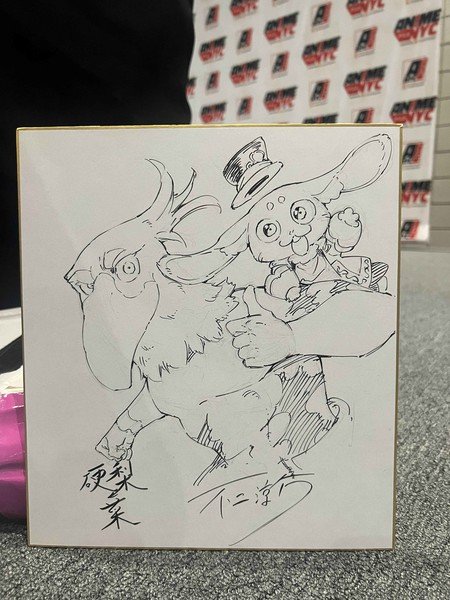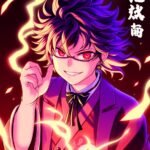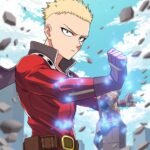Shangri-La Frontier
is an exciting action anime showcasing the fun exploits of our main character Sunraku. With a spoonbill bird mask and an assortment of daggers by his side, Sunraku seeks to overcome challenges and learn more about the god-tier game Shangri-La Frontier
. At Anime NYC
, series creator Katarina
and manga artist Ryōsuke Fuji
, made an appearance to talk about their series, with the web novel author coming complete with a mask that matched the main character he created. Anime News Network sat down and spoke with both of them privately to learn more about what developing such an enriching game world was like.

Shangri-La Frontier light novel author Katarina and manga artist Ryosuke FujiPhotography by Deb Aoki
Photo ©Anime News Network, Shangri-La Frontier ©硬梨菜・不二涼介・講談社/「シャングリラ・フロンティア」製作委員会・MBS
How did you originally come up with someone like Sunraku as the main character, someone who is obsessed with or sees the challenge in beating games that he admits are poorly designed and broken?
KATARINA: So, you know how there’s a sense of achievement that follows after you beat a really tough game? That can be said about any game, but mostly, it’s about well-designed games that are meant to be difficult. When we’re talking about trash games, they’re difficult because of an unexpected reason. I wanted to have this character who enjoys this unexpectedness, along with that difficult challenge. That’s how I came up with the character of Sunraku.
Interesting! As a gamer, I understand that mentality. Fuji-san, what sort of techniques did you use to make Sunraku so emotive when he has a bird head?
Ryōsuke Fuji: Initially, I was gonna have the eyes on the spoonbill mask do the acting. But then I soon realized that his beak, you know, when you move the beak, you can make a different kind of expression. Realizing that kind of increased the range of emotions that I could create with his mask on. He’s the only character in the game that has a bird head. So, no matter what I did with his face, you know viewers can recognize it as Sunraku. It was a very fun character design to work with.
And did working with this design feel any different compared to making expressions for the human-like characters?
FUJI: Yeah, it was very different. If I made a human face character with the exaggerated facial expressions that Sunraku was making, then you wouldn’t be able to recognize that character.
Would either of you want to play a game like Shangri-La Frontier if it were a real, fully immersive game? What kind of class would you play, or what type of stats would you prioritize?
KATARINA: I do like playing hack-and-slash video games, so I definitely would love to play Shangri-La Frontier. But I also like the type of game where you acquire materials and make something out of the ones you acquire, so I could also be like a weapon-maker or something.
FUJI: So Shangri-La Frontier has a lot of AI involved in it. I would play it and maybe have a lot of interactions with NPCs. The third town, in particular, has a lot of interesting characters, so I would probably be in that area interacting with everyone a lot.
I’m very curious, where did the idea for Sunraku to wear the bird mask or just barely show his in-game face come from?
KATARINA: You know, in games like Dark Souls and Monster Hunter, you see the players with headgear only and no equipment underneath? Recently, in Elden Ring, I saw a character or a player who said, “You know, I want to fight the boss alone,” and he or she fought the boss with a jar on their head and no equipment underneath. So, the idea of a strong, good player with something on top and nothing underneath struck a chord with me, and that’s how I came up with that character.
When creating the game’s NPCs, monsters, and bosses, was there any particular design philosophy?
FUJI: When I’m creating a design for monsters, for example, I also think about what kind of battle scenes I want or need to draw. So, you know, if Sunraku needs to hold onto a part of the monster, then, you know, what part would he be holding on to? So it goes hand in hand; the character design and the visual of the battle.
So, does the design come conceptually from how the monster will fight?
FUJI: Yeah. So first, I think about the highlight of the battle scene, and then I think about how to make that scenario happen with the monster’s design. So that’s kind of how it happens.
When adapting Katarina’s light novel into a manga, how much did the two of you collaborate to get the right “look” for the world?
FUJI: Because the novel is so detailed, I will develop the first draft based on what Katarina-sensei wrote and give it to him. He will give me, you know, feedback and supervise things from there.
When you say first draft, are you referring to the storyboards?
FUJI: Yes, the storyboards, but also just the characters’ designs and the look of the overall setting.
I really love the character dynamics between Sunraku, Arthur, and OiKatzo. The three of them are all expert gamers who rely on each other but also love getting on each other’s nerves. What was it like writing character interactions between them?
KATARINA: So their interactions were kind of inspired by Hollywood movies and the banter you see from the characters. Instead of, you know, saying hello to each other, they’ll say something like “What’s wrong with your face?” but you know that it’s based on friendship. The characters also know each other’s boundaries, so they know just how to hit the other back, either with their words or their fists physically. That’s the kind of relationship I wanted the three of them to have.

Photography by Deb Aoki
Photo ©Anime News Network Shangri-La Frontier ©硬梨菜・不二涼介・講談社/「シャングリラ・フロンティア」製作委員会・MBS
What character design was the most fun for you? Which one was the most challenging?
FUJI: So the fun characters to draw were definitely the bunny rabbits. It’s not just them individually, but as a tribe, they were very fun to draw. The challenging character to draw was Wethermon the Tombguard because later in the story, he would start to have cracks all over his body where his aura would leak out and stuff. It took a lot of time and energy to draw, but at the same time, it was really rewarding and enjoyable to draw him as well.
Correct me if I’m wrong, but the manga adaptation of Shangri-La Frontier is unique in that there weren’t pre-existing character designs from the light novel version. Can you talk about the decision to go straight from the web novel to the manga version?
FUJI: So, main character-wise, there was a very firm, solid imagery from Katarina-sensei about what Sunraku should look like. But in terms of the other characters, like you mentioned, there was no information of how they visually looked. So a lot of my personal preferences were involved in designing them. But Katarina-sensei was very accepting of my creativity. So that’s kind of how it happened.
How long did it take to develop the lore of the world of Shangri-La Frontier? Did you have a bunch of concepts for the stories ahead of time before you started writing? Or was it something you built up as you wrote the story over time?
KATARINA: I originally developed this work as a fantasy story first, where everything was real, like an isekai. But then I decided to put the whole thing in the VR game setting. So definitely, the world-building of Shangri-La Frontier came first. What kind of culture would be there? What kind of towns exist? I established the world view of Shangri-La Frontier, and then after that, I asked, “What kind of player would play the story?” That’s the order of how I created the story.
Were there any games that served as direct influences for Shangri-La Frontier?
KATARINA: I would say, you know, something like Dark Souls, where the worldview and world-building were very impressive. Games like that and Xenoblade influenced Shangri-La Frontier, too.
FUJI: Oh also Horizon Zero Dawn! You know, mechanical animals roam the world, and things like that influenced the creatures and world designs.











